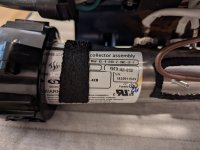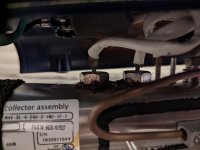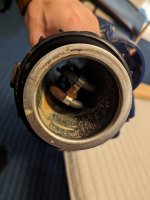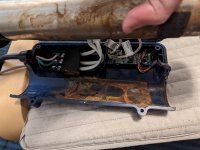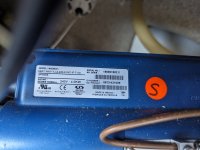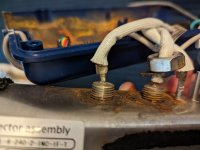My spa heater recently failed. The spa started tripping the breaker. A tech came out and determined the heater was the cause (he disconnected the heater and the breaker stopped tripping). After the $180 diagnosis fee and a quoted $350 for replacement heater (which I can find for $228 on first Google) + additional for labor, I decided to DIY a fix, hopefully by swapping out just the heating element. I have removed the heater assembly and am now figuring out next steps. Here is the situation (there are also attached images):
- According to the tech, the heater is a Watkins 77358. This does indeed look like my heater. I am a little confused because I don't see "77358" anywhere on the actual heater, which lists a model number of HEAT.WAV-YJ-4-240-2-INC-IF-T-V3 (see picture) and a brand of Gecko, but I guess this is just a different model #/brand slapped on the Watkins.
- The spa is 4 years old (purchased new Aug 2019) and was used for 3.5 years (was unpowered/unfilled for 6 months after a move).
- The last year of use it has been sanitized with a SmarterSpa salt water generator. Prior to that, the first year was trichlor followed by 1.5 years of bleach.
- Haven't been incredibly conscientious about water chemistry but haven't let things go to extremes. Typically refilled every ~4 months with average of maybe 30-person-minutes a day of use.
- When pH was out of the ideal range, it was almost always higher (>=7.8). Almost never had low pH.
- I observe light corrosion on the inside and outside of the heater tube and on the heater element. There is much heavier corrosion on the heater terminal bolts.
Here are my questions:
- Does the corrosion inside/outside the heater tube mean that I need to replace the whole tube + element, or would it be OK to just replace the element?
- What would happen if I just cleaned the corrosion off the terminals with a wire brush? Seems like this could be a viable fix if it's just "normal" slowly accumulating buildup over years of use?
- The tech told me that heaters regularly fail every 5ish years. Is this always due to corrosion? Any other causes of heater failure?
- Is the level of corrosion on my heater "normal wear and tear", or does it indicate something unusual?
- Amazon has various heating elements advertised as universal. I see they vary in length (7" and 9") and wattage. My heater is 4kW and I haven't yet removed/measured the element. In general, can I expect any of these 4kW elements to work with my heater? Is it important to match the length of the existing element or any other parameter?
- According to the tech, the heater is a Watkins 77358. This does indeed look like my heater. I am a little confused because I don't see "77358" anywhere on the actual heater, which lists a model number of HEAT.WAV-YJ-4-240-2-INC-IF-T-V3 (see picture) and a brand of Gecko, but I guess this is just a different model #/brand slapped on the Watkins.
- The spa is 4 years old (purchased new Aug 2019) and was used for 3.5 years (was unpowered/unfilled for 6 months after a move).
- The last year of use it has been sanitized with a SmarterSpa salt water generator. Prior to that, the first year was trichlor followed by 1.5 years of bleach.
- Haven't been incredibly conscientious about water chemistry but haven't let things go to extremes. Typically refilled every ~4 months with average of maybe 30-person-minutes a day of use.
- When pH was out of the ideal range, it was almost always higher (>=7.8). Almost never had low pH.
- I observe light corrosion on the inside and outside of the heater tube and on the heater element. There is much heavier corrosion on the heater terminal bolts.
Here are my questions:
- Does the corrosion inside/outside the heater tube mean that I need to replace the whole tube + element, or would it be OK to just replace the element?
- What would happen if I just cleaned the corrosion off the terminals with a wire brush? Seems like this could be a viable fix if it's just "normal" slowly accumulating buildup over years of use?
- The tech told me that heaters regularly fail every 5ish years. Is this always due to corrosion? Any other causes of heater failure?
- Is the level of corrosion on my heater "normal wear and tear", or does it indicate something unusual?
- Amazon has various heating elements advertised as universal. I see they vary in length (7" and 9") and wattage. My heater is 4kW and I haven't yet removed/measured the element. In general, can I expect any of these 4kW elements to work with my heater? Is it important to match the length of the existing element or any other parameter?


